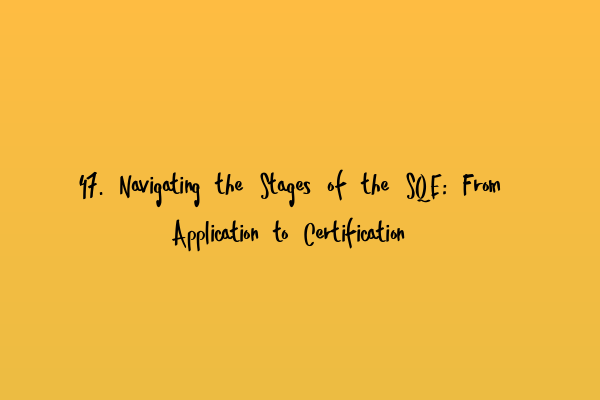47. Navigating the Stages of the SQE: From Application to Certification
Are you preparing to take the Solicitors Qualifying Examination (SQE)? The SQE is an essential step on your journey to becoming a qualified solicitor, and understanding the stages of the process can help you navigate it successfully. In this blog post, we will guide you through the various stages of the SQE, from application to certification. So, let’s dive in and explore each stage in detail.
Stage 1: Application
The first stage of the SQE is the application process. This is where you apply to sit the examination and provide the necessary information and documentation. It’s important to carefully review the application requirements, as any errors or missing documents could delay your application or even result in its rejection.
To ensure a smooth application process, familiarize yourself with the application guidelines provided by the Solicitors Regulation Authority (SRA). Additionally, it’s essential to gather all the required documents, such as transcripts, identification, and character references, well in advance to avoid any last-minute hurdles.
If you’re looking for strategies to ace the SQE, check out our article on SQE Strategies: Proven Tactics to Ace the Solicitors Qualifying Examination. It will provide you with valuable insights and tips to boost your exam preparation.
Stage 2: Preparation
Once your application is accepted, it’s time to shift your focus to exam preparation. The SQE is a rigorous assessment that tests your practical legal skills and knowledge. Therefore, it’s crucial to develop a well-rounded study plan and allocate sufficient time to each topic and practice area.
One effective method to apply your knowledge in real-life scenarios is through SQE case studies. These case studies help you understand how to apply legal principles to practical situations. To learn more about the importance of case studies in your SQE preparation, read our article on SQE Case Studies: Applying Knowledge in Real-Life Scenarios.
During the preparation stage, it’s also vital to familiarize yourself with the exam structure, question types, and time management techniques. This will enable you to plan and execute your exam strategy effectively. For tips on planning and executing for optimal performance, check out our article on SQE Exam Strategy: Planning and Executing for Optimal Performance.
Stage 3: Sitting the SQE
The next stage is sitting the SQE itself. This includes both SQE1 and SQE2 exams, which assess your legal knowledge and practical skills. The SQE1 is a computer-based multiple-choice examination, while the SQE2 is a practical legal skills assessment.
During the examination, it’s essential to manage your time effectively to ensure you can complete all the required tasks. Time management is a crucial skill for success in the SQE. To master time management and develop strategies for efficient exam completion, refer to our article on Mastering Time Management in SQE: Strategies for Efficient Exam Completion.
Remember to stay focused during the examination, carefully read each question, and provide clear and concise answers. Don’t forget to utilize your knowledge from case studies to analyze and handle practical scenarios effectively.
Stage 4: Results and Certification
Once you’ve completed the SQE, it’s time to await your results. The SRA will notify you of your exam scores in due course. If you have successfully passed both SQE1 and SQE2, congratulations! You’re one step closer to becoming a qualified solicitor.
After receiving your results, you will need to apply for admission to the role of solicitor with the SRA. This process involves submitting an application form, providing the required documentation, and paying the necessary fees. Once your admission is approved, you will officially become a certified solicitor.
Conclusion
Successfully navigating the stages of the SQE, from application to certification, requires careful planning, thorough preparation, and effective execution. By following the outlined stages and utilizing the recommended resources and strategies, you can increase your chances of achieving success in the SQE.
Remember to review our related articles for further guidance:
– SQE Strategies: Proven Tactics to Ace the Solicitors Qualifying Examination
– SQE Case Studies: Applying Knowledge in Real-Life Scenarios
– SQE Exam Strategy: Planning and Executing for Optimal Performance
– Solicitors Qualifying Examination (SQE): Your Gateway to Legal Practice
– Mastering Time Management in SQE: Strategies for Efficient Exam Completion
We wish you the best of luck in your SQE journey! With dedication and strategic preparation, you can achieve your goal of becoming a qualified solicitor.
